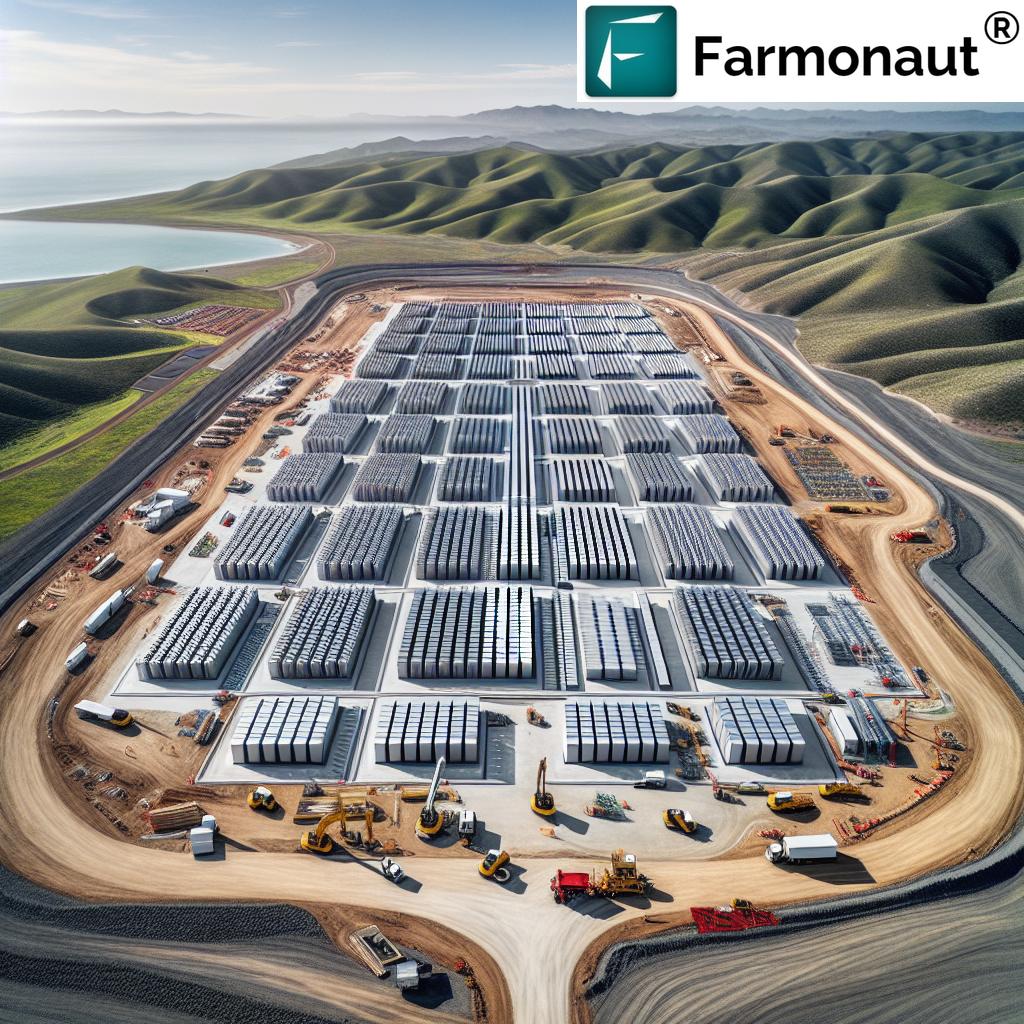Revolutionizing Australia’s Energy Future: Massive Battery Storage Project Boosts Grid Stability in South Australia
“Australia’s new battery project boasts a 250MW / 500MWh capacity, part of a massive 10GWh energy storage pipeline.”
In a groundbreaking development that marks a significant milestone in Australia’s energy transition, we are witnessing the dawn of a new era in renewable energy storage and green energy infrastructure. The announcement of a massive battery storage project in South Australia is set to transform the country’s energy landscape, propelling it towards a cleaner, more sustainable future.
As we delve into the details of this revolutionary project, we’ll explore its far-reaching implications for grid stability, clean energy investments, and Australia’s commitment to achieving net-zero emissions. This blog post will provide a comprehensive analysis of the project, its impact on the energy sector, and the broader context of Australia’s evolving energy infrastructure.
The Limestone Coast North Energy Park: A Game-Changer in Energy Storage
At the heart of this transformative initiative is the Limestone Coast North Energy Park, a 250MW / 500MWh battery energy storage system that forms part of an ambitious 10GWh pipeline. This utility-scale battery project, valued at an impressive A$460 million, represents a substantial investment in sustainable energy technology and large-scale energy storage.
The project is being developed by Pacific Green Technologies, Inc. (OTCQB: PGTK), a global leader in energy storage and environmental technology solutions. In a recent announcement, Pacific Green revealed that it has signed binding documentation for the sale of 100% of the shares in its Limestone Coast North Energy Park to Intera Renewables (Intera), marking a significant milestone in the project’s development.

Let’s break down the key aspects of this groundbreaking project:
- Capacity: 250MW / 500MWh
- Location: Limestone Coast region of South Australia
- Expected Commercial Operations: Early 2027
- Investment Value: A$460 million (US$293 million)
- Developer: Pacific Green Technologies, Inc.
- Acquirer: Intera Renewables (majority owned by Palisade Investment Partners)
This project is not just a standalone achievement; it’s part of a broader vision for Australia’s energy future. Pacific Green is rolling out a 10GWh development pipeline of battery energy parks throughout the country, positioning itself as a leading player in Australia’s utility-scale battery development landscape.
The Impact on Grid Stability and Australia’s Net-Zero Transition
The Limestone Coast North Energy Park is poised to significantly strengthen the region’s grid stability, addressing one of the most pressing challenges in the transition to renewable energy. As Australia moves towards a greater reliance on intermittent renewable sources like wind and solar, the need for robust energy storage solutions becomes increasingly critical.
Here’s how this project will contribute to grid stability and accelerate Australia’s net-zero transition:
- Enhanced Grid Reliability: The battery storage system will help balance supply and demand, especially during peak usage periods or when renewable generation is low.
- Frequency Regulation: It will provide rapid response capabilities to maintain grid frequency within acceptable limits, crucial for preventing blackouts.
- Renewable Integration: By storing excess renewable energy and releasing it when needed, the project will enable greater integration of wind and solar power into the grid.
- Reduced Reliance on Fossil Fuels: The increased storage capacity will diminish the need for gas-fired peaker plants, traditionally used to meet peak demand.
- Support for Net-Zero Goals: By enabling higher penetration of renewables, the project aligns with Australia’s commitment to achieving net-zero emissions.
As we consider the transformative potential of this project, it’s worth noting the role of innovative technologies in the broader agricultural sector. Companies like Farmonaut are leveraging advanced satellite technology and AI to revolutionize farming practices, contributing to sustainability efforts across industries.
A Closer Look at the Transaction and Key Players
The sale of the Limestone Coast North Energy Park to Intera Renewables marks a significant milestone in the project’s development. Let’s examine the key players and details of this transaction:
- Seller: Pacific Green Technologies, Inc. (OTCQB: PGTK)
- Buyer: Intera Renewables
- Enterprise Value: A$460 million (US$293 million)
- Transaction Structure: Sale of 100% of the shares in Limestone Coast North Energy Park
Intera Renewables is the renewable energy platform established and majority-owned by funds managed by Palisade Investment Partners, an Australian-based infrastructure and real assets manager. This acquisition aligns with Palisade’s strategy to invest in critical infrastructure that supports Australia’s clean energy transition.
“The A$460 million battery storage system in South Australia is set to begin commercial operations by early 2027.”
As part of the transaction, Pacific Green will be retained to manage the construction of the project through to commercial operations. Following this, Palisade Integrated Management Services (PIMS) will take over asset management activities through its role as Intera’s asset manager.
The Broader Context: Australia’s Energy Transition
The Limestone Coast North Energy Park is not an isolated development but part of a larger trend in Australia’s energy sector. The country is rapidly transitioning towards renewable energy, driven by a combination of factors:
- Ambitious climate targets
- Falling costs of renewable technologies
- Increasing public support for clean energy
- The need to replace aging coal-fired power plants
To provide context, let’s look at a comparison of large-scale battery storage projects in Australia:
| Project Name | Location | Capacity (MW/MWh) | Investment Value (A$ million) | Expected Completion Date | Key Benefits |
|---|---|---|---|---|---|
| Limestone Coast North Energy Park | South Australia | 250 / 500 | 460 | Early 2027 | Grid stability, renewable integration |
| Victorian Big Battery | Victoria | 300 / 450 | 300 | Operational (2021) | Peak demand management, grid reliability |
| Waratah Super Battery | New South Wales | 700 / 1400 | 1,000 | 2025 | Network support, increased transmission capacity |
| Hornsdale Power Reserve | South Australia | 150 / 194 | 172 | Operational (2017, expanded 2020) | Frequency control, grid stabilization |
This table illustrates the significant scale of the Limestone Coast North Energy Park project in comparison to other major battery storage initiatives in Australia. It’s clear that the country is making substantial investments in energy storage infrastructure to support its renewable energy goals.
The Role of Battery Storage in Australia’s Energy Future
Battery energy storage systems (BESS) play a crucial role in Australia’s transition to a renewable energy-dominated grid. Here’s why they are so important:
- Bridging the Gap: BESS helps bridge the gap between variable renewable energy generation and consistent electricity demand.
- Grid Stability: These systems provide essential services like frequency regulation and voltage support, maintaining grid stability.
- Peak Shaving: By storing energy during low-demand periods and releasing it during peak times, BESS helps reduce strain on the grid and lower electricity prices.
- Renewable Integration: Large-scale batteries enable greater integration of wind and solar power by storing excess energy for later use.
- Resilience: In the event of grid failures or natural disasters, BESS can provide backup power, enhancing overall system resilience.

The Limestone Coast North Energy Park, with its substantial 250MW / 500MWh capacity, will significantly contribute to these benefits, positioning South Australia at the forefront of the energy transition.
Pacific Green’s Vision for Australia’s Energy Landscape
Pacific Green’s ambitious plans extend beyond the Limestone Coast North project. The company is positioning itself as a leading utility-scale battery developer in Australia, with a multi-gigawatt platform in the works. Here’s a glimpse into their pipeline:
- Limestone Coast West: A 250MW / 1,000MWh battery energy storage development, expected to commence construction in September 2025.
- Portland Energy Park: A massive 1,000MW / 2,500MWh project across four co-located battery assets in Victoria, with construction slated to begin in March 2026.
- Wagga Wagga Project: Pacific Green recently acquired land rights in Wagga Wagga, New South Wales, marking the company’s first project in the state.
This extensive pipeline demonstrates Pacific Green’s commitment to building a 10GWh portfolio of battery energy parks throughout Australia, leveraging the team’s significant experience in developing similar projects in Europe.
As we consider the scale of these energy infrastructure projects, it’s worth noting the parallels with innovations in other sectors. For instance, agricultural technology companies like Farmonaut are also leveraging advanced technologies to drive sustainability and efficiency. Learn more about Farmonaut’s innovative solutions through their Android app or iOS app.
The Economic and Environmental Impact
The development of large-scale battery storage projects like the Limestone Coast North Energy Park has significant economic and environmental implications:
Economic Benefits:
- Job Creation: The construction and operation of these facilities create both short-term and long-term employment opportunities.
- Investment Attraction: Such projects attract further investment in the renewable energy sector, boosting the local and national economy.
- Energy Cost Reduction: By improving grid efficiency and reducing reliance on expensive peaker plants, these projects can help lower electricity costs for consumers.
- Export Opportunities: Australia could become a leader in battery storage technology, opening up potential export markets for expertise and services.
Environmental Impact:
- Carbon Emission Reduction: By enabling greater renewable energy integration, these projects contribute significantly to reducing carbon emissions.
- Fossil Fuel Displacement: Large-scale batteries reduce the need for fossil fuel-based power generation, particularly for peak demand periods.
- Resource Efficiency: Energy storage improves the utilization of renewable resources, reducing waste and improving overall system efficiency.
- Ecosystem Protection: By facilitating the transition away from fossil fuels, these projects help mitigate the environmental impacts associated with traditional power generation.
The Limestone Coast North Energy Park, along with Pacific Green’s broader portfolio of projects, is set to play a crucial role in Australia’s energy transition, delivering both economic benefits and environmental sustainability.
Challenges and Considerations
While the prospects for large-scale battery storage in Australia are exciting, it’s important to acknowledge the challenges and considerations associated with these projects:
- Technological Advancements: The rapidly evolving nature of battery technology means that projects must be flexible enough to incorporate future improvements.
- Regulatory Framework: As a relatively new technology at this scale, battery storage projects may face evolving regulatory landscapes that need to be navigated carefully.
- Grid Integration: Ensuring seamless integration with existing grid infrastructure and management systems is crucial for maximizing the benefits of these projects.
- Supply Chain Considerations: The global demand for battery components could impact project timelines and costs.
- End-of-Life Management: Developing sustainable recycling and disposal methods for large-scale batteries will be critical as these projects mature.
Addressing these challenges will be crucial for the long-term success and sustainability of Australia’s battery storage initiatives.
The Global Context: Australia’s Position in the Energy Storage Landscape
Australia’s ambitious battery storage projects, including the Limestone Coast North Energy Park, position the country as a global leader in renewable energy integration and grid stability solutions. This leadership role has several implications:
- International Collaboration: Australia’s experiences and innovations in large-scale energy storage can inform global best practices and foster international cooperation.
- Technology Export: As Australian companies like Pacific Green gain expertise in developing and operating these systems, there’s potential for exporting this knowledge and technology to other countries.
- Climate Action Leadership: By demonstrating the feasibility of high renewable energy penetration supported by advanced storage systems, Australia can inspire and guide other nations in their energy transitions.
- Research and Development Hub: The concentration of large-scale battery projects could establish Australia as a center for energy storage research and innovation.
As we consider Australia’s role in the global energy landscape, it’s worth noting that innovation in energy and sustainability extends across various sectors. For instance, in agriculture, companies like Farmonaut are leveraging advanced technologies to promote sustainable farming practices. Explore Farmonaut’s innovative solutions through their web application.
Future Outlook and Conclusions
The Limestone Coast North Energy Park and Pacific Green’s broader portfolio of projects represent a significant leap forward in Australia’s journey towards a sustainable, renewable-powered future. As these projects come online over the next few years, we can expect to see:
- Increased grid stability and reliability across Australia
- Greater integration of renewable energy sources into the national power mix
- Reduced reliance on fossil fuels for electricity generation
- Potential reduction in electricity costs for consumers
- Acceleration towards Australia’s net-zero emissions targets
The success of these projects could serve as a blueprint for other countries looking to transition to renewable energy systems, potentially establishing Australia as a global leader in large-scale energy storage solutions.
As we look to the future, it’s clear that the energy landscape is rapidly evolving, with battery storage playing a pivotal role. The Limestone Coast North Energy Park is not just a single project, but a symbol of Australia’s commitment to innovation, sustainability, and a cleaner energy future.
FAQ Section
- Q: What is the capacity of the Limestone Coast North Energy Park?
A: The project has a capacity of 250MW / 500MWh. - Q: When is the project expected to begin commercial operations?
A: Commercial operations are expected to start by early 2027. - Q: Who is developing the Limestone Coast North Energy Park?
A: The project is being developed by Pacific Green Technologies, Inc. - Q: What is the investment value of the project?
A: The project is valued at A$460 million (US$293 million). - Q: How will this project benefit Australia’s energy grid?
A: The project will enhance grid stability, enable greater integration of renewable energy sources, and support Australia’s transition to net-zero emissions.
Earn With Farmonaut: Affiliate Program
Earn 20% recurring commission with Farmonaut’s affiliate program by sharing your promo code and helping farmers save 10%. Onboard 10 Elite farmers monthly to earn a minimum of $148,000 annually—start now and grow your income!
Farmonaut Subscriptions
As we conclude this comprehensive analysis of Australia’s groundbreaking battery storage project, it’s clear that the country is at the forefront of the global energy transition. The Limestone Coast North Energy Park, along with Pacific Green’s ambitious pipeline of projects, represents a significant step towards a more sustainable and resilient energy future.
These developments not only showcase Australia’s commitment to renewable energy and grid stability but also highlight the country’s potential to become a global leader in large-scale energy storage solutions. As these projects come to fruition, they will undoubtedly play a crucial role in shaping Australia’s energy landscape and contributing to the global fight against climate change.
For those interested in staying updated on the latest developments in sustainable technology and innovation, don’t forget to explore Farmonaut’s range of solutions. Whether you’re looking to leverage satellite technology for agricultural purposes or interested in the latest advancements in precision farming, Farmonaut offers valuable insights and tools. Check out their API for developers or dive into their API Developer Docs for more information.
As we move forward, it’s exciting to imagine the possibilities that lie ahead in the realm of renewable energy and large-scale storage. Australia’s bold steps in this direction are not just transforming its own energy sector but are also setting an example for the rest of the world to follow.
















